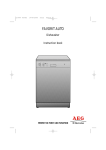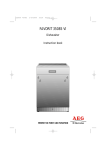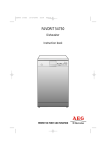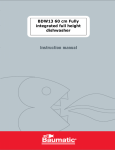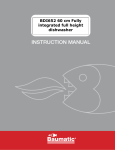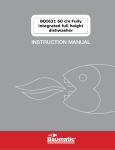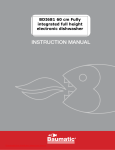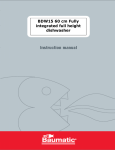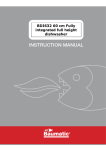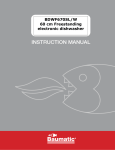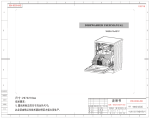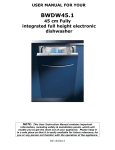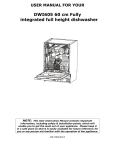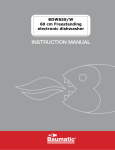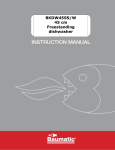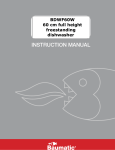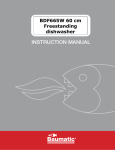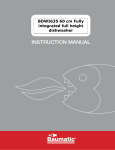Download Instruction Manual
Transcript
USER MANUAL FOR YOUR BYDI630 60 cm Fully integrated full height dishwasher NOTE: This User Instruction Manual contains important information, including safety & installation points, which will enable you to get the most out of your appliance. Please keep it in a safe place so that it is easily available for future reference; for you or any person not familiar with the operation of the appliance. GS 30/09/13 Contents Environmental note Important safety information 4 5–7 Specifications Dimensions Specifications Electrical details 8–9 8 8–9 9 Description of the appliance Control panel 10 – 11 11 Using your dishwasher Before first use Filling with dishwasher salt Setting the water softener level Filling with rinse aid Setting the rinse aid level Filling with dishwasher detergent Concentrated detergent Detergent tablets Loading the upper basket Adjusting the upper basket Loading the lower basket The cutlery basket Loading dishes and cutlery 11 11 11 12 13 14 15 16 16 16 17 18 19 20 Program table Setting a wash program Changing a wash program Adding more dishes At the end of a wash program Rinse aid and salt indicator neons 21 - 22 22 23 23 23 - 24 24 Cleaning and maintenance The filter system Cleaning the filters Cleaning the spray arms Cleaning the control panel Cleaning the door 24 - 27 24 - 25 25 - 26 26 26 27 Installation Aperture requirements Preparing and connecting the furniture door Adjusting the tension of the door spring Connecting to the mains water supply Connecting to the water outlet Connecting to the power supply Applying the condensation strip Positioning the dishwasher Levelling the appliance Securing the dishwasher Before first use Error code failure system General troubleshooting Technical data Contact details 27 27 28 30 31 32 32 33 34 34 35 36 36 38 40 41 - 21 – 12 - 13 - 14 - 18 - 19 - 21 - 36 - 28 – 29 - 33 - 34 - 35 - 36 – 37 – 39 3 ENVIRONMENTAL NOTE Note: Before discarding an old appliance, switch off and disconnect it from the power supply. Cut off and render any plug useless. Cut the cable off directly behind the appliance to prevent misuse. This should be undertaken by a competent person. Disable the door lock to make sure that children cannot get stuck inside the appliance. o The packaging materials that we use are environmentally friendly and can be recycled. o Please discard all packaging material with due regard for the environment. 4 IMPORTANT SAFETY INFORMATION Your safety is of the utmost importance to us. Please make sure that you read this instruction booklet before attempting to install or use the appliance. If you are unsure of any of the information contained in this booklet, please contact the Advice Line. General Safety o Repairs to your appliance must only be carried out by a registered engineer or one of our authorised service agents. Any attempt by an inexperienced person to repair the appliance, could result in injury or damage to your dishwasher. o If you notice that the mains cable is damaged. The appliance must not be used. The same applies if you notice that the worktop, control panel or base area is damaged. As this could allow access to the internal components of the machine. o The appliance should be turned off and isolated from the mains supply, before either cleaning or maintenance work is attempted. o The mains cable must not be used to pull the plug out of the electrical socket. o The machine should not be sprayed with water. o The external surface of the appliance may become hot whilst your dishwasher is in use. o It is possible for small animals to chew either mains cables or water hoses, which could cause an electric shock hazard. Installation o The installation instructions contained within this user manual should be followed. o It is obligatory for the completed installation to comply with all relevant building regulations and local water authority requirements. o Before the first use of the appliance, you should follow the steps listed in the “Before first use” section on page 11 and page 36 of this manual. 5 o Care should be taken not to trap the power supply cable underneath the appliance whilst installing it. o No attempt should be made to alter or modify the specifications of this appliance. In daily use o This appliance is only designed to wash normal domestic washloads. If you use your dishwasher in any other way or it is incorrectly used, then we accept no liability for any damage that might be caused and any guarantee will be void. o It is recommended that the appliance is unplugged and the water supply is turned off after the machine is used. o The detergents, rinse aid and salt that you place in this appliance should be suitable for automatic dishwashers. With regards to dosage levels, the detergent manufacturer’s recommendations should be followed. o Sharp knifes or ones with long blades are a potential safety hazard when placed in an upright position in the cutlery basket. We would recommend that these items are placed horizontally in the upper basket. o You should not wash any items that have come into contact with corrosive, acidic or alkaline chemicals, paint, petrol, iron or steel debris. o You should not open the door whilst the appliance is set on a wash program. Depending on which stage that the wash program is at, hot water could escape the machine. o You should not leave the door of the appliance open, unless you are loading or unloading the dishwasher. o You should not stand or sit on the door when it is open. 6 Child Safety o Your dishwasher should only be used by adults. You should not allow children in the area of the machine unsupervised. You should not let them touch the controls or play with the appliance. o It could be possible for a child or pet to gain access to the dishwasher if the door is left open. Therefore please check the inside of the appliance before setting it on a wash cycle. o Any packaging that is removed from the machine should be kept away from children. o All detergents should be kept out of children’s reach in a safe place. o Some water will remain inside the dishwasher when it has completed a wash cycle. This water is not suitable for drinking and may contain residues from the detergents that are used in the appliance. Declaration of conformity This appliance complies with the following European Directives: -73/23 dated 19/02/1973 Low Voltage Directive and subsequent modifications. -89/336 dated 03/05/1989 Electromagnetic Compatibility Directive and subsequent modifications. For future reference please record the following information which can be found on the rating plate and the date of purchase which can be found on your sales invoice. The rating plate of your dishwasher is located on the right hand side of the drop down door. Model Number ………………………………. Serial Number ………………………………. Date of Purchase ………………………………. 7 Specifications Product dimensions Height: 820 - 850 mm Width: 595 mm Depth: 540 mm Aperture dimensions Height: 820 mm (min) Width: 600 mm Depth: 580 mm (min) Product specifications o 12 Place settings o 4 functions: Normal Economy Rapid All in 1 (3 in 1) o 4 temperatures: 40°C, 50°C, 55°C, 65°C o o o o o o o Self-cleaning stainless steel micro-filter Anti-leak device Anti-flood device Height adjustable upper basket Collapsible plate racks Adjustable feet Water softener Energy efficiency details Energy efficiency class: A+ Washing performance class: A Drying performance class: A 8 Electrical details Rated voltage: 230 Vac 50 Hz Supply connection: 10 A (double pole switched fused outlet with 3 mm contact gap) Optional extra o DWD600SS- Stainless steel door with mark resistant coating and bar handle. 9 Description of the appliance 1) 2) 3) 4) 5) 6) 7) 8) 9) 10) 11) 12) Upper basket Spray arms Lower basket Water softener Main filter Detergent dispenser Cup shelf Cutlery basket Coarse filter Rinse aid dispenser Drain pipe connector Inlet pipe connector 10 Control panel 1) 2) 3) 4) 5) ON/OFF button Salt warning neon Rinse aid warning neon Program button Program indicator lights Using your dishwasher Before first use o Install the appliance as per the installation instructions contained within this booklet. o Fill the water softener with ½ litre of tap water and then fill with specialist dishwasher salt. After this you should set the water softener level. o Fill the rinse aid dispenser and then set the rinse aid dosage. Filling with dishwasher salt IMPORTANT: You should only use salt that is specially designed for use in a dishwasher. If any other type of salt is used in the appliance (in particular table salt), it will damage the water softener. o Ideally you should fill the water softener with salt, just before you are about to run a wash program. This will help to clear any salt that may have overflowed from the water softener during the salt filling process. o Open the door of the dishwasher and then remove the lower basket. The basket should be empty when you remove it. o Turn the water softener cap anticlockwise and remove it. o Pour 1 litre of water into the water softener. 11 IMPORTANT: It is only necessary to do this when you fill the container with salt for the first time. o Pour salt into the water softener, using the funnel that is supplied with the appliance. You should add approximately 1 kg of salt into the water softener. o It is perfectly normal for a small amount of water to come out of the water softener, whilst you are filling it with salt. This does not mean that the water softener is filled with the correct amount of salt. o Refit and fully tighten the water softener cap. o The salt required warning light will go out approximately 2-6 hours after you have filled the water softener with salt. When the salt indicator neon lights on the control panel, then you should follow the filling with dishwasher salt procedure again. o IMPORTANT: You do not need to pour 1 litre of water into the container when you subsequently fill the water softener with salt. Setting the water softener level It is possible to regulate the amount of salt that the water softener will release during a wash cycle. The water softener should be set to a level that is appropriate for the hardness of your water (please refer to the table below). Water hardness level °DH °FH °Clark Mmol/l 35-45 61-80 43-56 6.1-8.0 23-34 41-60 29-42 4.1-6.0 18-22 31-40 22-28 3.1-4.0 12-17 21-30 15-21 2.1-3.0 6-11 10-20 7-14 1.0-2.0 0-5 0-9 0-6 0-0.9 *factory setting Water hardness display H6 H5 H4 H3* H2 H1 Relevant lights on Eco, Normal Normal, Rapid Normal Rapid, Eco Eco Rapid °DH : German degree °FH : French degree °Clark : British degree 12 To alter the amount of salt that is released by the water softener, you should:o Within 60 seconds of supplying power to the appliance, press and hold the program button (4) for 5 seconds. o The machine will enter the salt adjustment mode and the salt and rinse aid warning lights will flicker. o Use the program button (4) to set the correct water hardness level, according to the table above. The number of times a buzzer sounds indicates the selected level and at the same time the relevant program lights will come on, as shown in the table above. o For example, if the machine buzzes 3 times and the Rapid and Economy wash cycle lights come on simultaneously, this means level H3 is set. o After the desired level is displayed, release all buttons for 1 minute, or press the program button down for 3 seconds, and the machine level will be set. o IMPORTANT: If you are using 3 in 1 dishwasher tablets and live in a medium or hard water area, then you should still fill the water softener with salt. Filling with rinse aid The rinse aid is released during the final rinse and it helps to prevent water from forming droplets on your dishes. These droplets will lead to spots and streaks being left on items after the wash program has completed. o Your dishwasher is designed to utilise liquid rinse aid. o The rinse aid dispenser is located inside the drop down door, next to the detergent dispenser. 13 o To access the rinse aid dispenser, you should turn the cap anticlockwise and it will pop out of the hole (1). Then slowly pour in liquid rinse aid (2). o You should continue to fill with rinse aid, until the level indicator turns completely black. o Be careful not to overfill the dispenser, as this could cause oversudsing when a wash program is selected. Wipe away any rinse aid excess or spillages with a damp cloth. o Replace the cap and turn it clockwise until it locks into position (3). o You should refill the rinse aid dispenser when the rinse aid indicator neon lights on the control panel. o IMPORTANT: If you are using 3 in 1 dishwasher tablets then you should still fill the rinse aid dispenser. Setting the rinse aid level The amount of rinse aid that the dishwasher requires also depends on the hardness of your water. You should experiment with the rinse aid setting, until you find a level that gives the best results. o On the first wash cycle, we would recommend that the rinse aid level is set to number 2. o If you get water spots and poor drying performance, then you should turn the arrow anticlockwise and increase the setting to the next number. o You should continue to adjust the rinse aid level upwards until you get no water spots. o If you get cloudiness or streaking on your dishes, the rinse aid level is set too high and it is causing foaming during the wash cycle. Turn the arrow clockwise and lower the setting to the next number. 14 Filling with dishwasher detergent The detergent dispenser must be refilled at the start of each wash cycle. o Press the release button to open the lid. o The section marked A in the diagram is for the main wash cycle detergent. Only one detergent tablet should be placed in the dispenser at any one time. If you are using detergent powder or liquid, you should follow the detergent manufacturer’s recommendations. o The section marked B in the diagram can have separate detergent placed in it for any wash cycle that has a pre-wash element to it, however this is optional. If you have used a detergent tablet in section A you cannot use another in section B. You should use a powder of liquid detergent instead. o Shut the detergent dispenser lid and position the clip on the outer edge, so that it holds the lid shut. o At the beginning of a wash cycle the clip will open and the tablet/powder/liquid will enter the dishwasher. 15 Concentrated detergent o The use of the Normal wash program in combination with concentrated detergents reduces pollution and is good for your dishes. The Normal program is specifically matched to the dirtdissolving properties of the enzymes of the concentrated detergent. o In this way, the Normal wash program, in which concentrated detergents are used, can achieve the same results that can otherwise only be achieved using an intensive program. Detergent tablets o Detergent tablets of different brands dissolve at varying speeds. For this reason, some detergent tablets cannot dissolve and develop their full cleaning power during short programs. o You should select longer programs when using detergent tablets to ensure the complete removal of detergent residues. Loading the upper basket The upper basket is most suited to washing delicate and light dishware, such as glasses, coffee and tea cups, saucers, plates, bowls and shallow pans (that are not heavily soiled). 1. 2. 3. 4. 5. 6. 7. Cups Small serving bowl Large serving bowl Glasses Saucers Dish Dessert dishes o You should position the dishes and cookware in such a way that they are not moved by the spray of water during the wash cycle. o Use the diagram above as a guide to the most appropriate way to load the upper basket. 16 Adjusting the upper basket Your dishwasher has an adjustable upper basket which you can alter to the most suitable position for the items you are going to wash in the upper basket. o The height of the upper basket can be adjusted by removing the upper basket from the guide supports. o IMPORTANT: The upper basket must be empty when you are removing it from the guide supports. Lower position o If the upper wheels are placed in the guide supports, then the basket is in the lower position. o For accommodating additional tumblers, cups and mugs. You can also place small, espresso sized cups on top of the side racks. You should take care to ensure that there is enough clearance between the top of the cups placed on top of the side racks and the underneath of the dishwasher interior. IMPORTANT: Care should be taken when placing long stemmed glassware, such as champagne glasses in the upper basket. If they are not positioned correctly, then there is a risk that they may topple over when the upper basket is pushed in or pulled out. 17 Upper position o If the lower wheels are placed in the guide supports, then the basket is in the upper position. o For accommodating items such as glass tumblers and wine glasses. Wine glasses should be placed upside down, so that the stem of the glass rests in one of the grooves on the side flap. o Please note that when the basket is in the upper position, you cannot have the side flaps in a raised position. Otherwise the basket will not slide back into the interior of the dishwasher. IMPORTANT: Care should be taken to make sure that the spray arms can move freely when items have been loaded into the baskets. Loading the lower basket The lower basket is most suited to washing larger and more heavily soiled items, such as saucepans, saucepan lids and serving dishes. You can also load bowls and a variety of plates into the lower basket. 7. 8. 9. 10. 11. Dessert dishes Serving plate Dinner plates Side plates Cutlery basket o Saucepans and serving bowls must always be placed with their bases upwards. o Deep saucepans should be slanted, to allow water to run off. o The bottom rack has prongs at the rear of the basket that can be folded downwards, to allow for easier loading of larger saucepans and serving bowls. 18 The cutlery basket Cutlery should be placed inside of the cutlery basket. The cutlery basket should then be placed in the appropriate position in the lower basket. 1. 2. 3. 4. 5. 6. 7. 8. Forks Soup spoons Dessert spoons Teaspoons Knives Serving spoon Gravy ladle Serving fork o For the best washing performance, cutlery should be placed through the slots in the top of the cutlery basket. IMPORTANT: Do not allow items of cutlery to fall through the bottom of the cutlery basket, as this may cause damage to the spray arm and/or the cutlery. If the bottom of the basket begins to deteriorate and allows items to fall through, you should replace the cutlery basket. 19 Loading dishes and cutlery Household cloths, sponges or any other object that may absorb water SHOULD NOT be washed in a dishwasher. o Remove leftovers and soften the remnants of burnt food in pans, prior to loading dishes in the appliance. o Once the dishwasher has been loaded, check that the spray arms can move freely. If the spray arm comes into contact with any item, then you should rearrange the wash load. o Cups, glasses, pans etc should all be loaded with their bases upwards, so that water does not collect inside of them. o Cutlery and dishes should not cover each other; otherwise you may get poor wash results. o Do not allow glasses to touch inside the dishwasher, otherwise damage may occur. o Small objects can be placed inside of the cutlery basket. The following items are NOT suitable for washing inside a dishwasher:o Cutlery with a handle of mother-of-pearl, wood, horn or china. o Plastic items that are not resistant to heat. o Cutlery that consists of glued parts that are not resistant to heat. o Cutlery items or crockery that are bonded. o Copper or pewter items. o Lead crystal glass. o Wooden platters. o Synthetic fibre items. 20 The following items are not always suitable for washing inside a dishwasher:o Stoneware should only be washed if the manufacturer of the item has marked it as dishwasher safe. o Plastic items (such as lunchboxes) should only be washed if the manufacturer has marked it as dishwasher safe. o Glazed crockery may fade with repeated washing inside of a dishwasher. o Items made of silverware or aluminium can discolour when washed inside a dishwasher. o Any food residue should be removed from silver items immediately, as this can also result in discolouration. o Certain types of glass may become dull or cloudy after a large number of washes. Program table Program Cycle Information Description of cycle All in 1 For normally soiled loads, such as pots, plates, glasses and lightly soiled pans. A standard daily cycle. For normally soiled loads, such as pots, plates, glasses and lightly soiled pans. A standard daily cycle. For lightly soiled loads, such as plates, glasses, bowls and lightly soiled pans. Pre-wash (50°C) Wash (55°C) Rinse Rinse (65°C) Drying Normal Economy* Pre-wash (50°C) Wash (55°C) Rinse Rinse (65°C) Drying Pre-wash Pre-wash Wash (50°C) Rinse (65°C) Drying Detergent Pre/main All in 1 5/25g 5/25g Running time (min) Energy (Kwh) Water (L) 160 Minutes (2:40 hours on display) 1.35 16 160 Minutes (2:40 hours on display) 1.30 16 1.02 12 165 Minutes (2:45 hours on display) Rinse aid 21 Rapid A shorter wash for lightly soiled loads that do not need drying. Wash (40°C) Rinse Rinse (40°C) 20 g 30 minutes 0.5 11 *EN 50242. This programme is the test cycle. * The wash program times that are quoted are intended as a guide only. Please note that factors external to the machine, e.g. the temperature of your water supply, your water pressure etc. can affect the time it takes for the wash program to complete. Setting a wash program Make sure that the before first use section has been followed. o Check whether the appliance needs rinse aid or salt adding to it. o Pull out the top and bottom baskets, then load them in accordance with the loading instructions. o Push the top and bottom baskets fully back into position. o Add detergent. o Turn the appliance on by using the ON/OFF button (1). The power light will turn on. o IMPORTANT: Wait for 5 seconds before pressing the program selection button, otherwise the appliance may not function correctly. o Press the program selection button (4) to choose an appropriate wash program for the load that you are washing. The relevant program indicator neon (5) will light to show which program you have selected. o Close the door firmly, so that you hear the door lock click shut. o After a few seconds, you will hear the appliance begin to fill with water and the wash program will have started. 22 Changing the wash program IMPORTANT: This should only be attempted when the cycle has only just started, otherwise the detergent tablet may have already released or you could have hot water escaping. o Slightly open the door of the appliance to stop the current cycle. o Press and hold down the program selection button (4) for 3 seconds to cancel the wash program. Then use the program selection button (4) to choose the correct wash program. o Close the door firmly, so that you hear the door lock click shut. o After a few seconds, you will hear the appliance begin to fill with water and the wash program will have started. Adding more dishes IMPORTANT: Additional items can be added to the wash load if the cycle has only just started, otherwise the detergent tablet may have already released or you could have hot water escaping. o Slightly open the door of the appliance to stop the current cycle. o When the spray arms have stopped operating you can open the door completely. o Introduce the additional items into the appliance and close the door. o After a few seconds, you will hear the appliance continue with the washing cycle. At the end of a wash program o A buzzer will sound for 8 seconds and then stop. o Open the door of the appliance. o Use the ON/OFF button (1) to switch the dishwasher off and unload the contents. IMPORTANT: Wait for a few minutes before unloading the dishwasher to avoid handling the dishes and utensils while they are still hot and more susceptible to breakage. They will also dry better. 23 o It is normal for the dishwasher to be wet inside. o Empty the lower basket first and then the upper one. This will avoid water dripping from the upper basket onto the dishes in the lower one, causing streaking. Rinse aid and salt indicator neons o The rinse aid and salt indicator neons on the control panel will let you know when the appliance needs rinse aid or salt adding to it. neon indicates that you need to add rinse aid to the o The appliance. You should follow the procedure outlined on page 13 14. o The neon indicates that you need to add dishwasher salt to the appliance. You should follow the procedure outlined on page 11 – 12. Cleaning and maintenance IMPORTANT: The appliance should be disconnected from your mains supply before commencing any cleaning process. The filter system Your appliance is fitted with three levels of filtering; these are located in the base of the dishwasher for ease of access. Main filter- 1) Main filter 2) Coarse filter 3) Fine filter Food and soil particles are trapped by this filter and pulverised by a special jet on the lower spray arm. This debris is then washed down the drain. 24 Coarse filter- Larger items such as pieces of bone or glass, which could clog the drain, are trapped in this filter. Fine filter- This filter holds soil and food residue in the sump area and prevents it from being redeposited on the dishes during a wash cycle. IMPORTANT: Whilst the filtering system is efficient, your dishwasher is not a waste disposal unit. All items being washed inside of the dishwasher should have food scraps removed from them before being loaded into the appliance. Cleaning the filters For best performance and results, the entire filter assembly should be thoroughly cleaned regularly (ideally after each wash cycle). 1. Turn the coarse filter anticlockwise and then lift it upwards. Rinse out this section under a tap to remove any food debris that remains in it. 2. Pull out the main filter and rinse this under the tap to remove any food debris that is trapped in it. 3. Pull out the fine filter and rinse this under the tap to remove any food debris that is trapped in it. 4. Place the fine filter back in its original position. 5. Place the main and coarse filter back into their original positions in the base of the dishwasher. You must turn the coarse filter clockwise to lock it back into position. 25 IMPORTANT: If a glass gets smashed inside of the appliance, you must check there is no glass in the filter before the machine is used again as this can cause a drainage failure. IMPORTANT: THE DISHWASHER SHOULD NEVER BE SET ON A WASH CYCLE WITHOUT THE FILTERS BEING INSIDE OF THE APPLIANCE. Cleaning the spray arms The spray arms should be cleaned regularly, to prevent hard water deposits from clogging the spray arm jets and bearings. o To remove the spray arm, unscrew the nut and take out the washer that sits on top of the spray arm. o Gently pull upwards to remove the spray arm. o Wash the spray arm in warm, soapy water and use a soft brush to clean the jets. o Rinse the spray arm thoroughly and then reassemble the spray arm back in its original position. Cleaning the control panel IMPORTANT: Do not use any abrasive cleaner or household polish on either the control panel or operating parts. o Wipe over the control panel using a brand new damp cloth with warm water. 26 Cleaning the door o To clean the edge around the outside of the door, you should use a soft, damp cloth only. o To prevent water from penetrating the door lock or electrical components, DO NOT use a spray cleaner of any kind. o DO NOT use any abrasive cleaner or scouring pads on the inner or outer surfaces, as they may cause damage to them. Installation IMPORTANT: THIS INSTALLATION MUST BE COMPLETED BY A SUITABLY QUALIFIED PERSON. WE ONLY SANCTION THE INSTALLATION GIVEN IN THIS INSTRUCTION MANUAL. YOU SHOULD DISPOSE OF ALL PACKAGING IN AN ENVIRONMENTALLY FRIENDLY MANNER. Aperture requirements 27 o The aperture that your dishwasher needs to be installed into should resemble the one shown in the above drawing. o There should be no less than a 50 mm gap between the top of the dishwasher and the underneath of the worktop. Preparing and connecting the furniture door o IMPORTANT: The furniture door is not supplied with the appliance. You should purchase one to match with the rest of your kitchen cabinets. o The maximum weight of the furniture door should be 5.5 kilograms. The maximum thickness of the furniture door should be 15 mm. 28 o Use the installation template supplied with the appliance to mark up and then drill out the necessary holes in the furniture door. o Attach the upper hooks onto the furniture door. o Attach the lower hooks onto the furniture door. o Lift the furniture door towards the dishwasher door, ensuring that the upper and lower hooks locate into the slots on the outside of the dishwasher door. o Push the furniture door downwards so it locks into place on the dishwasher door. o Open the dishwasher door and find the covers that are located on either side of the outer edge. o Fully tighten the screws into the holes. Make sure that you screw them tightly into the furniture door. o Replace the covers. 29 Adjusting the tension of the door spring o The door of the dishwasher is attached to springs. These are set at the factory to ensure that they are at the proper tension, so that the door can open and close smoothly. o After the furniture door has been fitted, you will need to adjust the tension of the door spring. o Using an Allen key, rotate the adjusting screw to either tighten or slacken the steel cable. o The doors’ spring tension is correct when:a) The door remains horizontal when in the fully opened position. b) You are able to shut the door easily, by raising the door using your fingers. o WARNING: If you do not adjust the tension of the door spring, then it could cause damage to the appliance. 30 Connecting to the mains water supply IMPORTANT: Do not connect the appliance to your mains water supply using an old or an existing water inlet hose. The inlet hose supplied with the dishwasher is the ONLY one that should be used. DO NOT CONNECT THE WATER INLET HOSE TO A HOT WATER TAP. o The inlet hose will be located inside the cabinet of the dishwasher. o Connect the water inlet hose (C) to a threaded water tap (A) that has a 3/4” thread and to the inlet hose connector on the appliance. o Fully tighten the inlet hose to the water tap and the dishwasher. 31 Connecting to the water outlet Secure the drain hose, so that it cannot move whilst the dishwasher is in use. The drain hose can be hung in positions A, B or C. Place the end of the drain hose on your drain pipe. Push it a short way down into your drain pipe. IMPORTANT: Do not insert the drain hose too deeply into the pipe, as this may cause siphoning. NEVER EXTEND THE DRAINAGE HOSE FROM ITS ORIGINAL LENGTH. Connecting to the power supply IMPORTANT: The electrical socket must still be accessible once the appliance is installed. Consult the rating plate, located on the top of the drop down door BEFORE making the electrical connections. Ensure that the voltage reaching the plug is the same as that on the rating plate. 32 DO NOT REMOVE THE RATING PLATE AS THE INFORMATION ON IT IS IMPORTANT. The moulded plug that is supplied with the appliance must be placed into an earthed and insulated socket. Broken or damaged power leads must only be replaced by a suitably qualified person. A power lead of a similar type must be used in replacement. Power lead type – H 0 V V – F 3G 1,5. IMPORTANT: We do not recommend that this appliance is connected to an extension lead. Applying the condensation strip o The condensation strip must be fitted to the underside of the worktop to protect it against the ingress of moisture. The strip will deflect steam that rises from your appliance, away from the underneath of the worktop. o The condensation strip will be located inside of your dishwasher. o Ensure that the underneath of the worktop is clean before sticking the strip to it. o Separate the backing paper away from the strip. o Stick the condensation strip to the underneath of the worktop. o IMPORTANT: Failure to attach the condensation strip could result in damage to your worktop. 33 Positioning the dishwasher o Place the feet of the dishwasher into the slide rails. o Carefully slide the dishwasher back into position, underneath the worktop. Levelling the appliance o IMPORTANT: Your dishwasher must be level for it to operate properly. o Make sure that the dishwasher is supported whilst it is being levelled, otherwise it may tip over. o The rear feet can be adjusted by using the adjusting screw at the front of the appliance. o The front feet can be adjusted using a spanner. 34 o Use a spirit level to check that the appliance is level. o Check that the appliance is level from side to side. o Check that the appliance is level from front to back. Securing the dishwasher The dishwasher must be secured to the worktop, this can be done in one of two ways:o Standard worktop- Secure the dishwasher to the underside of the worktop by using two wood screws. o You should screw through the holes in the brackets at the top of the dishwasher cabinet. o These screws should be fully tightened. o Marble/granite worktop- The material of the worktop will mean that it is impossible to put a screw through the underneath of the worktop. o On either side of the front edge of the dishwasher cabinet, there is a rubber stopper. You should remove the rubber stoppers, to reveal a pre-drilled hole on either side of the dishwasher. o Secure the dishwasher to the cupboard either side of it, by screwing a wood screw through the pre-drilled holes into the cupboards. These screws should be fully tightened. o The rubber stoppers should then be refitted into their original position. 35 Before first use You should check the following before using the appliance for the first time:That That That That That That That salt. o That o o o o o o o the dishwasher is level and fixed in position. the water tap is fully open. there are no leaks at either end of the drain or inlet hoses. the inlet and outlet hose are fully tightened. the inlet and outlet hoses are not kinked. the power is switched on. the water softener has been filled with 1 litre of water and the rinse aid dispenser has been filled. Error code failure system If your appliance senses that it is not operating correctly, then a program indicator neon may flash. The following error codes can possibly be remedied by the customer and the steps outlined below should be followed. BEFORE COMPLETING ANY MAINTAINEANCE ON THE APPLIANCE, IT SHOULD BE DISCONNECTED FROM YOUR MAINS POWER SUPPLY. Codes The RAPID light flickers. Meaning Longer water inlet time. The NORMAL light flickers. Overfilled. Possible causes Tap is not open, water intake is restricted or water pressure is too low. Too much inlet water. o Once you have taken action to rectify the problem that has caused the fault code to appear, plug the machine back into your mains power supply. o Turn the machine on using the ON/OFF button (1) and wait for 5 seconds, before attempting to set a wash program, using the program selection button. IMPORTANT: If any other of the program indicator neons flash, you should not attempt to clear it yourself and contact the Advice Line. 36 IF THE FAULT CODE REAPPEARS AFTER FOLLOWING THE ABOVE ADVICE AND CLEARING THE FAULT CODE. YOU SHOULD TURN OFF THE APPLIANCE; DISCONNECT THE APPLIANCE FROM YOUR MAINS SUPPLY. THEN ARRANGE FOR AN ENGINEER TO ATTEND THE APPLIANCE. YOU SHOULD CONTACT THE ADVICE LINE ON TELEPHONE NUMBER (0118) 933 6918. Please note that if an engineer is asked to attend whilst the product is under guarantee and finds that the problem is not the result of an appliance fault, then you may be liable for the cost of the call out charge. The appliance must be accessible for the engineer to perform any necessary repair. If your appliance is installed in such a way that an engineer is concerned that damage will be caused to the appliance or your kitchen, then they will not complete a repair. This includes situations sealed in with sealant, front of the appliance than the one specified in where appliances have been tiled in, have wooden obstructions placed in like plinths, or any installation other this manual has been completed. Please refer to the conditions of guarantee that appear on the warranty card that you receive with the appliance. IMPORTANT: We operate a policy of continuous improvement and reserve the right to adjust and modify our products without prior notification. 37 General troubleshooting Problem Dishwasher does not start. Water not pumped from dishwasher. Suds in the tub. Stained tub interior. White film on inside surface. There are rust stains on cutlery. Knocking noise in the wash cabinet. Rattling noise in the wash cabinet. Knocking noise in the water pipes. Possible causes What to do Technical problems Fuse blown or the circuit Replace fuse or rest circuit breaker. breaker acted. Remove any other appliances sharing the same circuit with the dishwasher. Power supply is not turned Make sure the dishwasher is turned on on. and the door is closed securely. Make sure the power cord is properly plugged into the wall socket. Water pressure is too low. Check that the water supply is connected properly and the water is turned on. Door of dishwasher not Make sure to close the door properly and properly closed. latch it. Kink in the drain hose. Check the drain hose. Filter clogged. Check the coarse filter (see section “Cleaning the filter”). Kitchen sink clogged. Check the kitchen sink to make sure it is draining well. If the problem is the kitchen sink not draining, you may need a plumber rather than a service engineer for dishwashers. General problems Improper detergent. Use only the special dishwasher detergent to avoid suds. If this occurs, open the dishwasher and let the suds evaporate. Add 1 gallon of cold water to the tub. Close and latch the dishwasher then start the rapid wash cycle to drain out the water. Repeat if necessary. Spilled rinse aid. Always wipe up rinse aid spills immediately. Detergent with colorant Make sure that the detergent is one was used. without colorant. Hard water minerals. To clean the interior, use a damp sponge with dishwasher detergent and wear rubber gloves. Never use any other cleaner than dishwasher detergent for the risk of foaming or suds. The affected items are not corrosion resistant. A program was not run Always run the rapid wash program after dishwasher salt was without any crockery in the dishwasher added. Traces of salt have after adding dishwasher salt. gotten into the wash cycle. The lid of the softener is Check the lip. Ensure the fix is fine. loose. Noise A spray arm is knocking Interrupt the program and rearrange the against an item in a items which are obstructing the spray basket. arm. Items of crockery are Interrupt the program and rearrange the loose in the wash cabinet. items of crockery. This may be caused by onsite installation or the cross-section of the piping. This has no influence on the dishwasher function. If in doubt, contact a suitably qualified plumber. 38 The dishes are not clean. Cloudiness on glassware. Black or grey marks on dishes. Detergent left in dispenser cups. The dishes are not drying. Unsatisfactory washing results The dishes were not See “Loading the dishwasher baskets” loaded correctly. section. The program was not Select a more intensive program. See the powerful enough. “wash cycle table”. Not enough detergent was Use more detergent or change your dispensed. detergent. Items are blocking the Rearrange the items so that the spray can path of the spray arms. rotate freely. The filter combination in Clean and/or fit the filter combination the base of the wash correctly. cabinet is not clean or is Clean the spray arm jets. See the not correctly fitted. This “Cleaning the spray arms” section. may cause the spray arm jets to get blocked. Combination of soft water Use less detergent if you have soft water and too much detergent. and select a shorter cycle to wash the glassware and to get them clean. Aluminium utensils have Use a mild abrasive cleaner to eliminate rubbed against dishes. those marks. Dishes blocking detergent Reload the dishes properly. cups. Unsatisfactory drying results Improper loading. Load the dishwasher as suggested in the directions. Too little rinse-aid. Increase the amount of rinse aid / refill the rinse aid dispenser. Dishes are removed too Do not empty your dishwasher soon. immediately after washing. Open the door slightly so that the steam can escape. Begin unloading the dishwasher only once the dishes are barely warm to the touch. Empty the lower basket first. This prevents water from dropping off dishes in the upper basket. Wrong program has been In short programs the washing selected. temperature is lower. This also lowers the cleaning performance. Choose a program with a long washing time. Use of cutlery with a low Water drainage is more difficult with these quality coating. items. Cutlery or dishes of this type are not suitable for washing in the dishwasher. 39 Technical Data Manufacturer Model Number Standard Place Settings Energy Efficiency Class (1) Annual Energy Consumption (2) Energy Consumption of the Standard Cleaning Cycle Power Consumption of Off Mode Power Consumption of Left-On Mode Annual Water Consumption (3) Drying Efficiency Class (4) Standard Cleaning Cycle (5) Program Duration of the Standard Cleaning Cycle Noise Level Installation Type HOMEKING BYDI630 12 A+ 291 kWh 1.02 kWh 0.00 W 0.40 W 3360 litres A Economy 50°C 165 mins 53 dB Built-in (1) On a scale from A+++ (highest efficiency) to D (lowest efficiency). (2) Annual energy consumption based on 280 standard cleaning cycles using cold water fill and the consumption of the low power modes. The actual energy consumption will depend on how the appliance is used. (3) Annual water consumption based on 280 standard cleaning cycles. The actual water consumption will depend on how the appliance is used. (4) On a scale from A (highest efficiency) to G (lowest efficiency). (5) This program is suitable for cleaning normally soiled tableware and is the most efficient program in terms of combined energy and water consumption. United Kingdom 6 Bennet Road, Reading, Berkshire RG2 0QX United Kingdom Customer Care (0118) 933 6918








































